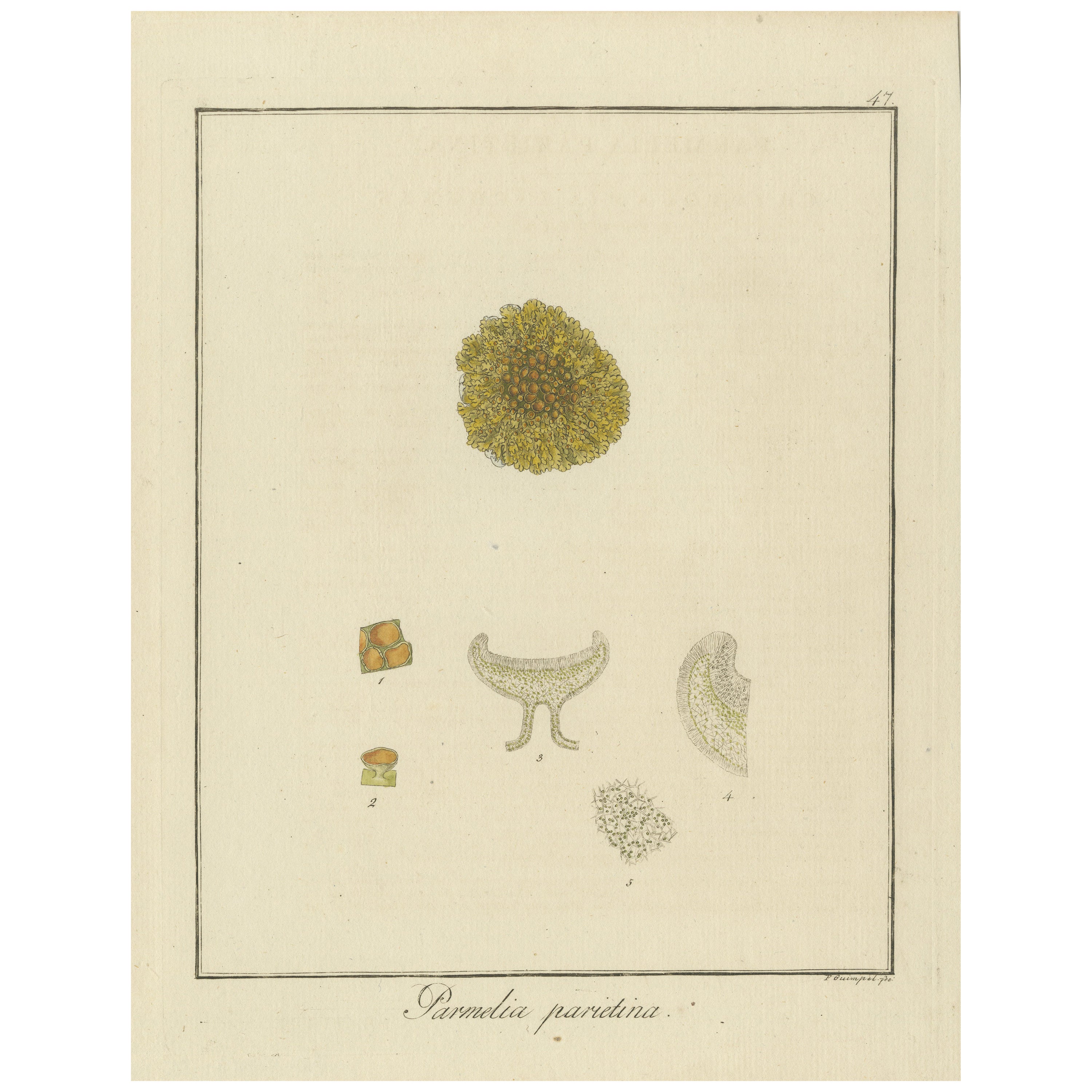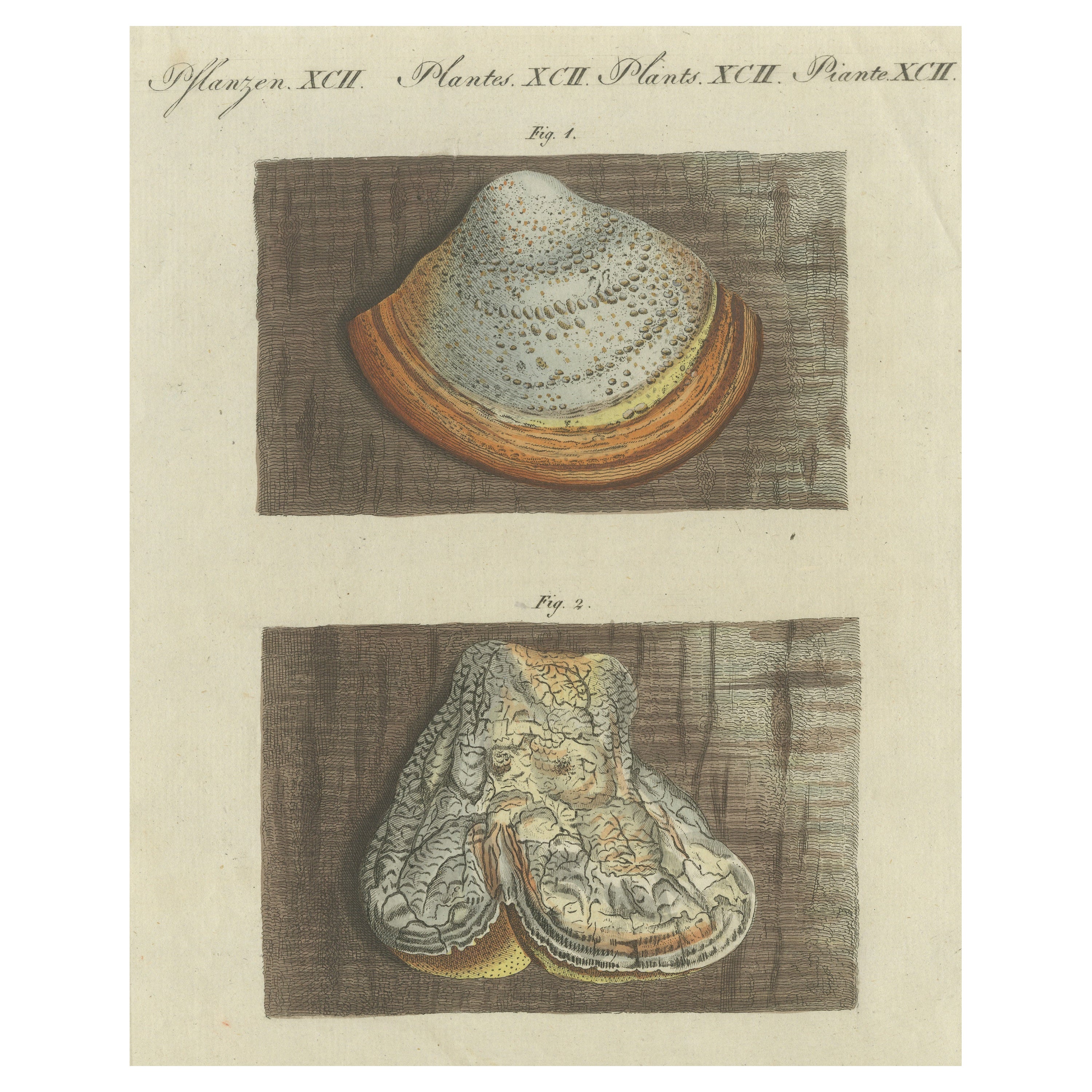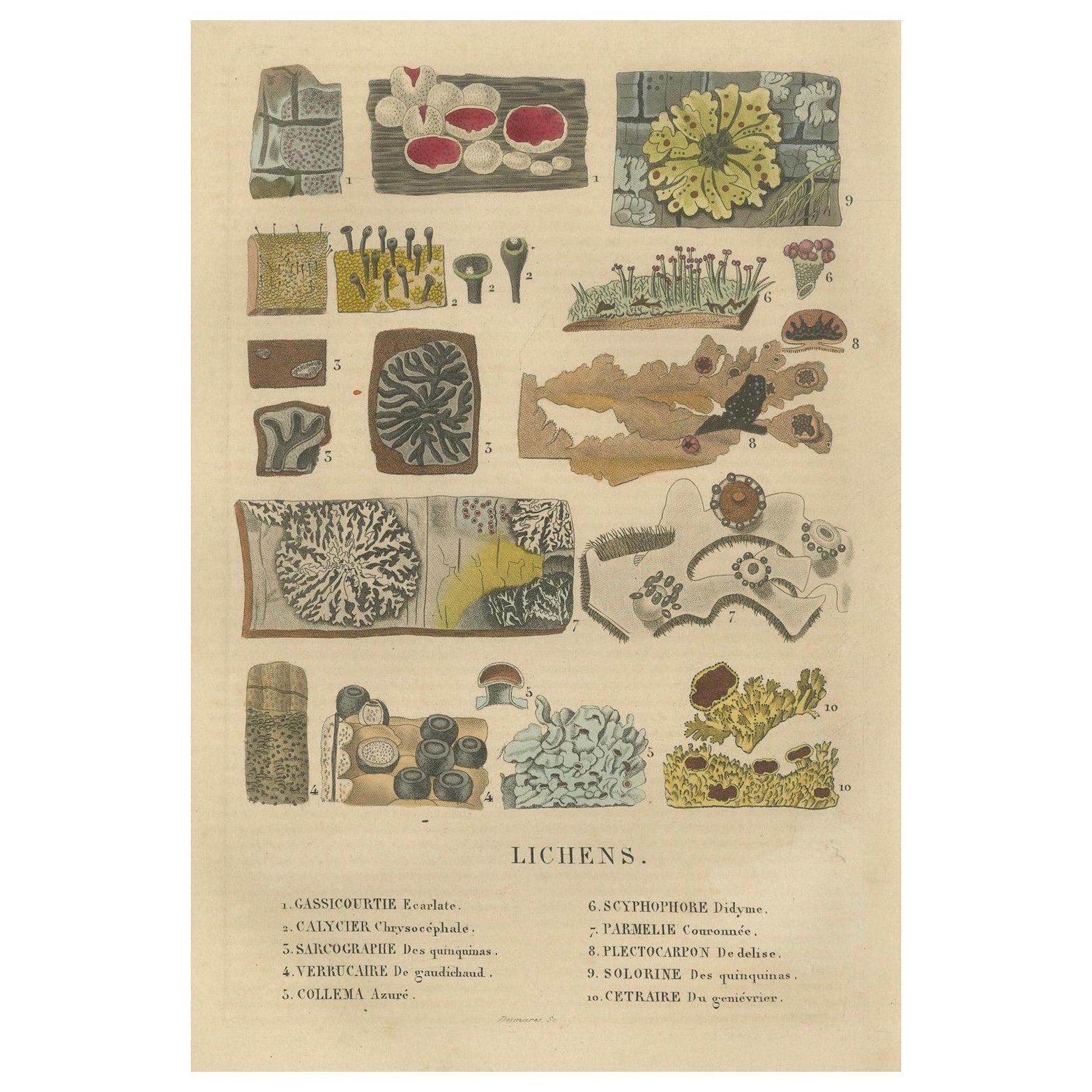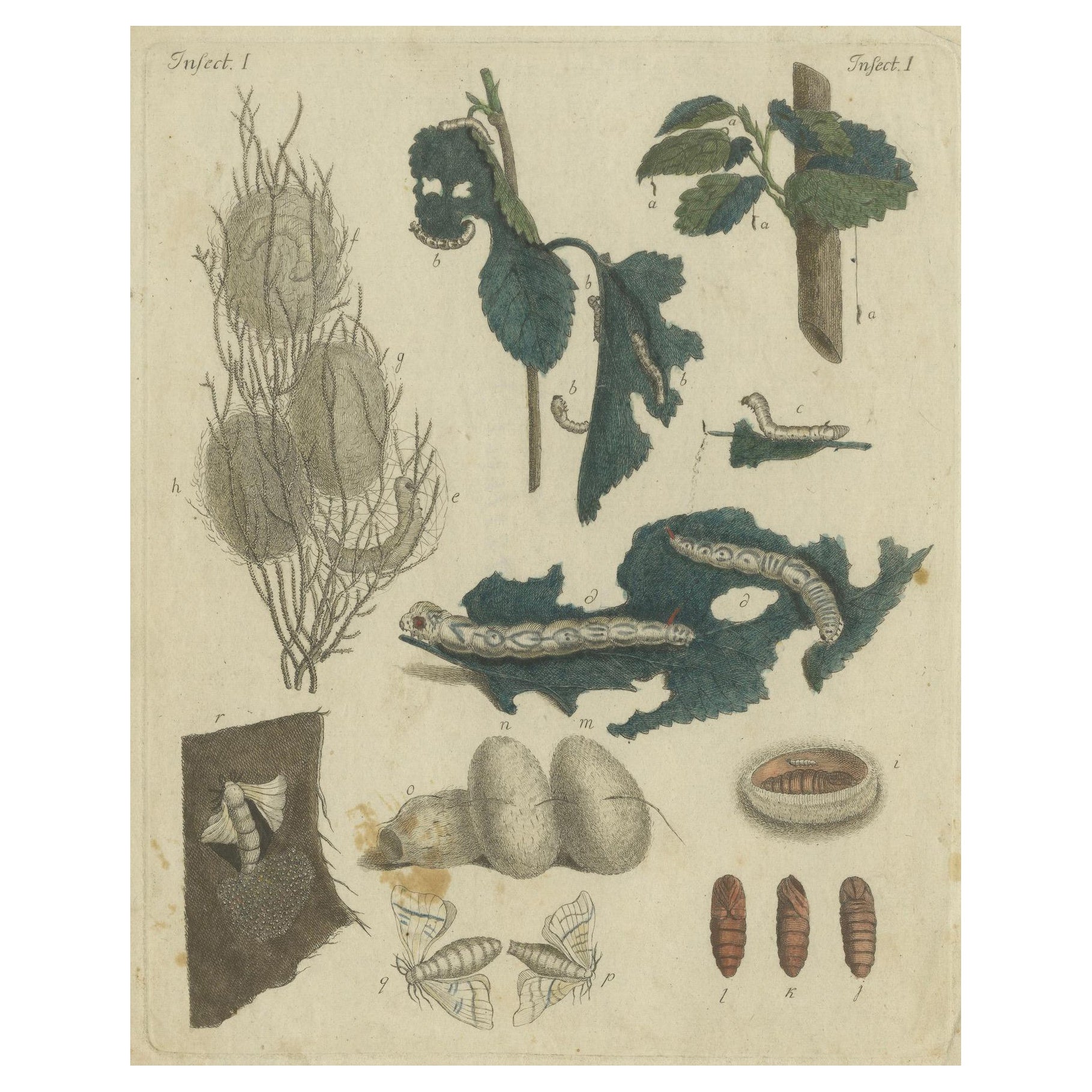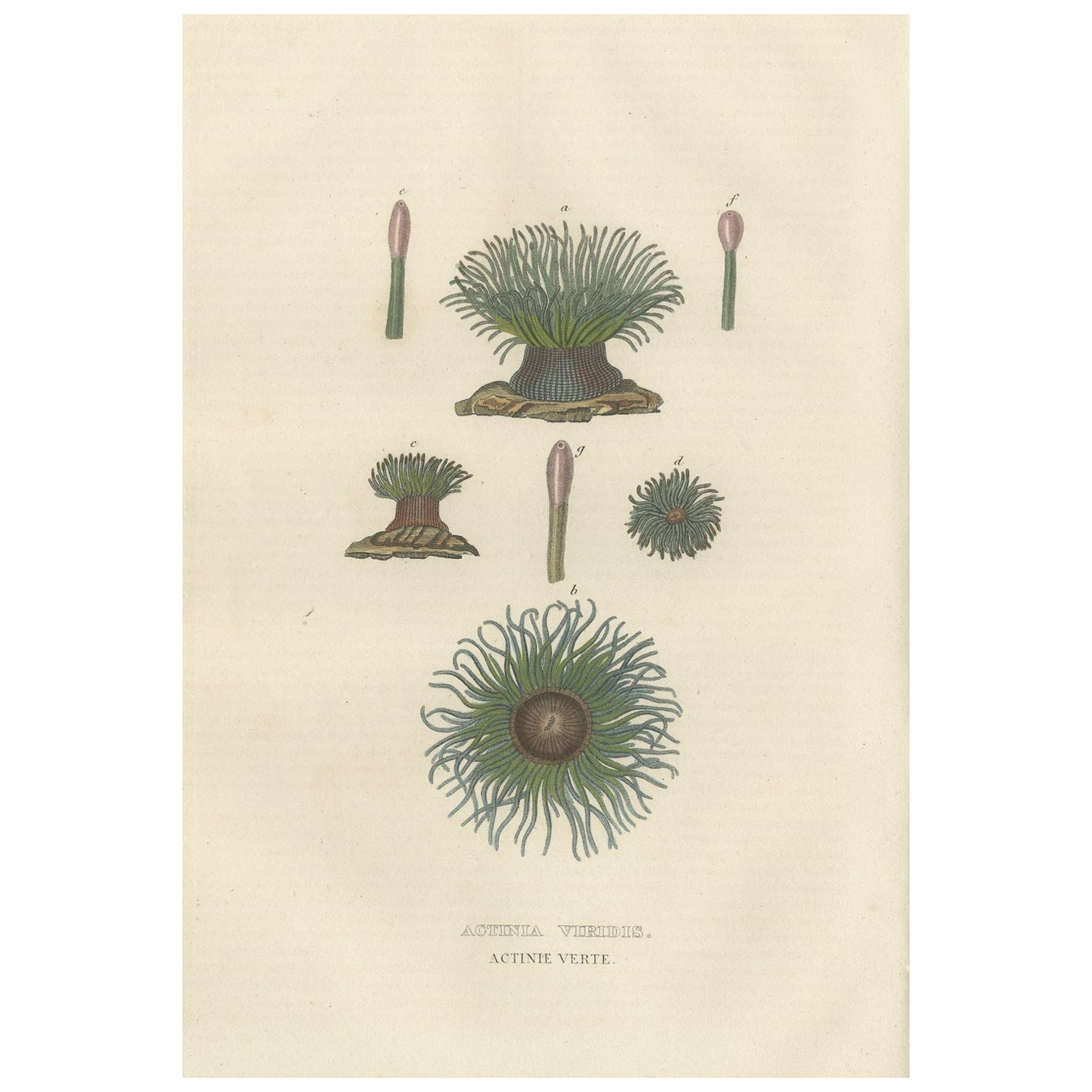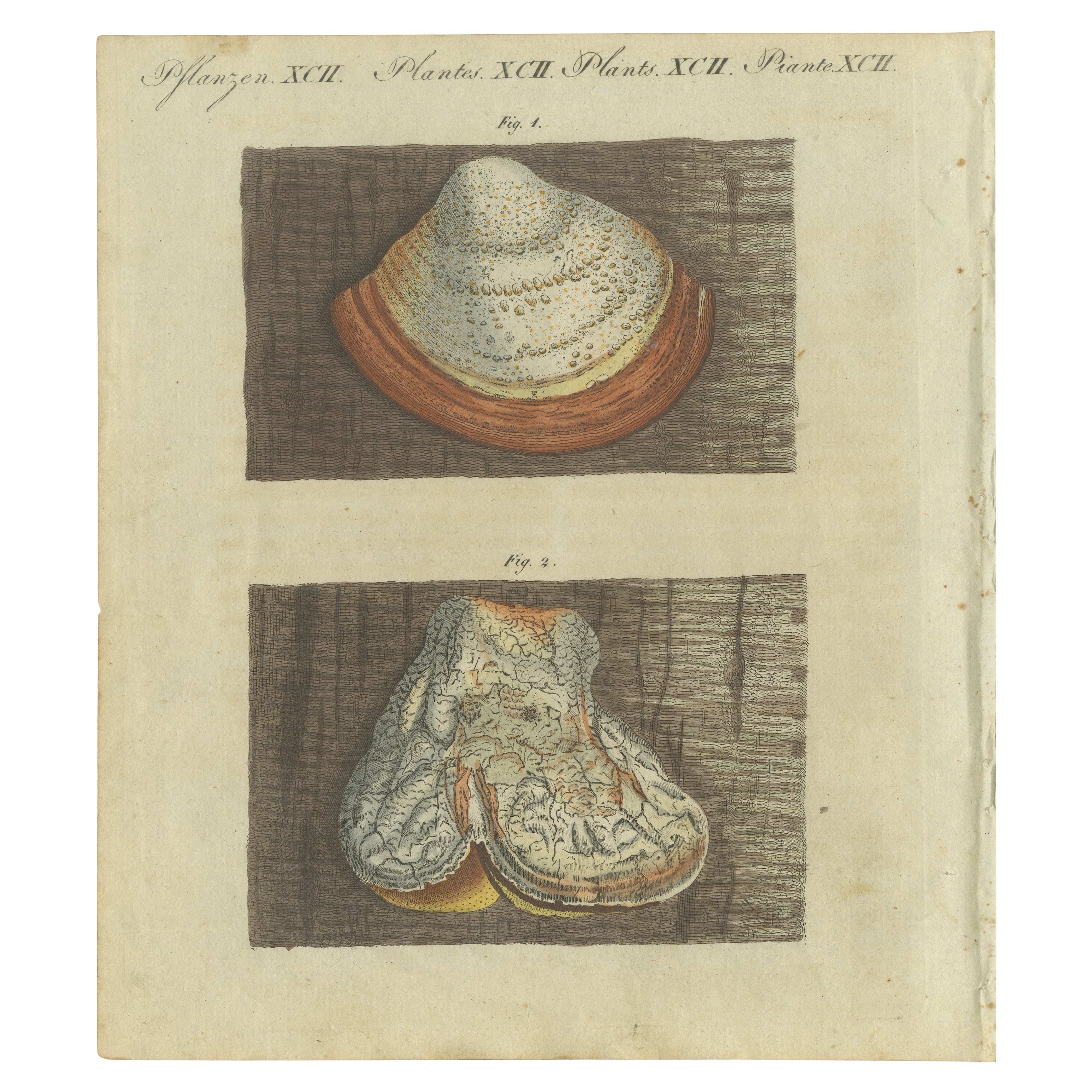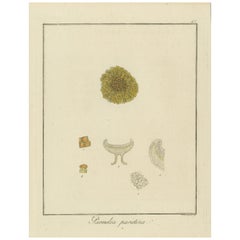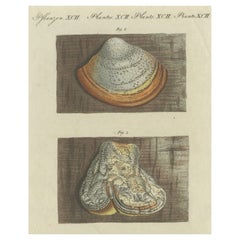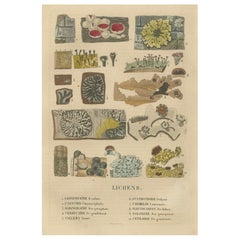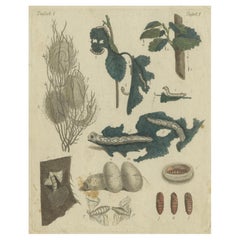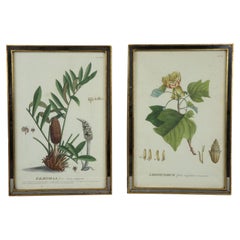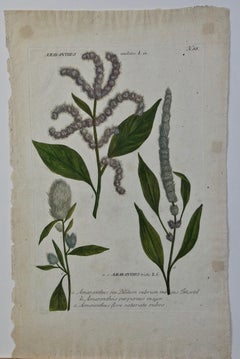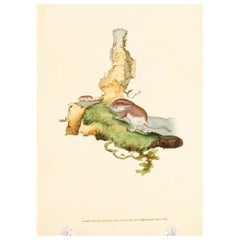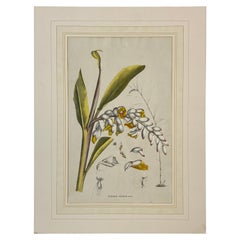Items Similar to Hand-Colored Engraving of Shield Lichen, Parmelia saxatilis, by F. Guimpel, 1819
Want more images or videos?
Request additional images or videos from the seller
1 of 7
Hand-Colored Engraving of Shield Lichen, Parmelia saxatilis, by F. Guimpel, 1819
$277.80
$347.2520% Off
£205.35
£256.6920% Off
€232
€29020% Off
CA$377.82
CA$472.2820% Off
A$423.35
A$529.1820% Off
CHF 220.37
CHF 275.4620% Off
MX$5,179
MX$6,473.7520% Off
NOK 2,797.17
NOK 3,496.4620% Off
SEK 2,641.89
SEK 3,302.3720% Off
DKK 1,766.57
DKK 2,208.2120% Off
Shipping
Retrieving quote...The 1stDibs Promise:
Authenticity Guarantee,
Money-Back Guarantee,
24-Hour Cancellation
About the Item
The image is an original antique hand-colored copperplate engraving of the lichen "Parmelia saxatilis", commonly known as the shield lichen. The detailed illustrations include different views and sections of the lichen to highlight its characteristics. The title given in the engraving is "Parmelia saxatilis."
The engraving of Parmelia saxatilis by F. Guimpel was published in the 6th edition of "Getreue Darstellung und Beschreibung der in der Arzenykunde gebrauchlichen Gewächse", which translates to "Faithful Representation and Description of Plants Used in Medicine." This work was authored by Dr. Friedrich Gottlob Hayne, a German botanist, and it is a detailed collection focused on plants of medicinal value.
The 6th edition was published in 1819. The title reflects the comprehensive nature of Hayne's work in documenting and illustrating plants, including lichens like Parmelia saxatilis, that were significant in pharmacology and botany of that time.
To summarize:
Title of Work: Getreue Darstellung und Beschreibung der in der Arzenykunde gebrauchlichen Gewächse (Faithful Representation and Description of Plants Used in Medicine)
Edition: 6th Edition
Publication Year: 1819
Engraver: F. Guimpel
The presence of a watermark on the handmade paper indicates the authenticity and quality of the material used during that period.
More in Detail:
Parmelia saxatilis, commonly known as the shield lichen, is a lichen that is widely distributed across various regions, particularly in the Northern Hemisphere. Here are some details about its habitat and uses:
Habitat:
- Geographical Distribution: Parmelia saxatilis can be found in many parts of the world, including North America, Europe, and parts of Asia. It thrives in temperate and boreal regions.
- Growth Environment: This lichen typically grows on rocks, but it can also be found on soil and tree bark. It prefers well-lit, open habitats such as mountainous areas, rocky outcrops, and sometimes open woodland.
- Climate Preferences: It is well-adapted to cold and temperate climates and can endure a range of environmental conditions, including high altitudes and areas with considerable exposure to wind and rain.
Uses:
- Traditional Medicine: Historically, Parmelia saxatilis has been used in folk medicine. It was believed to have medicinal properties, such as treating wounds and respiratory issues, although such uses are not well-documented in modern scientific literature.
- Dye Production: One of the well-known uses of this lichen is in dye production. It contains lichen substances that can produce a range of colors, from browns and purples to reddish hues, when treated with different chemical mordants.
- Indicator Species: As a lichen, Parmelia saxatilis is sensitive to air quality, making it an indicator species for environmental monitoring. The presence or absence of this lichen can provide insights into air pollution levels, especially sulfur dioxide pollution.
- Ecological Role: Lichens like Parmelia saxatilis play important roles in ecosystems. They help in soil formation by breaking down rocks, provide food and habitat for various organisms, and contribute to nutrient cycles.
While its use in traditional medicine is less common today, its ecological importance and application in natural dyeing processes still hold value.
- Dimensions:Height: 10.83 in (27.5 cm)Width: 8.55 in (21.7 cm)Depth: 0 in (0.02 mm)
- Materials and Techniques:Paper,Engraved
- Period:
- Date of Manufacture:1819
- Condition:Condition: excellent given age. General age-related toning and/or occasional minor defects from handling. Please study scan carefully.
- Seller Location:Langweer, NL
- Reference Number:Seller: BG-13747-101stDibs: LU3054341258152
About the Seller
5.0
Recognized Seller
These prestigious sellers are industry leaders and represent the highest echelon for item quality and design.
Platinum Seller
Premium sellers with a 4.7+ rating and 24-hour response times
Established in 2009
1stDibs seller since 2017
2,493 sales on 1stDibs
Typical response time: <1 hour
- ShippingRetrieving quote...Shipping from: Langweer, Netherlands
- Return Policy
Authenticity Guarantee
In the unlikely event there’s an issue with an item’s authenticity, contact us within 1 year for a full refund. DetailsMoney-Back Guarantee
If your item is not as described, is damaged in transit, or does not arrive, contact us within 7 days for a full refund. Details24-Hour Cancellation
You have a 24-hour grace period in which to reconsider your purchase, with no questions asked.Vetted Professional Sellers
Our world-class sellers must adhere to strict standards for service and quality, maintaining the integrity of our listings.Price-Match Guarantee
If you find that a seller listed the same item for a lower price elsewhere, we’ll match it.Trusted Global Delivery
Our best-in-class carrier network provides specialized shipping options worldwide, including custom delivery.More From This Seller
View AllEngraving of Common Orange Lichen, Parmelia parietina, Published in 1819
Located in Langweer, NL
The image is a hand-colored copperplate engraving of "Parmelia parietina," commonly known as the common orange lichen or wall lichen. This detailed botanical illustration shows the l...
Category
Antique 1810s Prints
Materials
Paper
$277 Sale Price
20% Off
Hand Colored Engraving of Phellinus Igniarius and Laricifomes Officinalis Fungi
Located in Langweer, NL
Original antique print of Phellinus igniarius and Laricifomes officinalis. Phellinus igniarius (syn. Phellinus trivialis) is a fungus of the family Hymenochaetaceae. Like other membe...
Category
Antique Late 18th Century Prints
Materials
Paper
$172 Sale Price
20% Off
Lichen Varieties: A Collection of Symbiotic Elegance Engraved and Colored, 1845
Located in Langweer, NL
The image is an intricate hand-colored engraving showcasing a variety of lichen species. Lichens are symbiotic organisms composed of fungi and algae living together. They are known f...
Category
Antique 1840s Prints
Materials
Paper
$268 Sale Price
20% Off
Antique Handcolored Engraving of Silkworm Life Cycle, c.1800
Located in Langweer, NL
Antique Handcolored Engraving of Silkworm Life Cycle, Insects I, c.1800
This original handcolored copperplate engraving depicts the life cycle of the silkworm (*Bombyx mori*), hig...
Category
Antique Early 1800s Prints
Materials
Paper
19th Century Snakelocks Anemone Antique Engraving Original Handcoloring, 1845
Located in Langweer, NL
Original antique illustration of a depiction of Actinia viridis, commonly known as the Snakelocks Anemone. These creatures possess a green hue due to the presence of a green fluoresc...
Category
Antique 1840s Prints
Materials
Paper
$162 Sale Price
20% Off
1805 Hand-Colored Engraving of Fungi Specimens from Bertuch’s Work
Located in Langweer, NL
Title: 1805 Hand-Colored Engraving of Fungi Specimens from Bertuch’s Work
Description:
This stunning hand-colored engraving comes from Friedrich Justin Bertuch’s *Porte-Feuille ...
Category
Antique Early 1800s Prints
Materials
Paper
You May Also Like
Two 18th Century Hand Colored Botanical Engraving of Plants from (1771)
Located in Stockholm, SE
Adorning the walls, two gracefully framed botanical engravings from 1771 capture nature's elegance in exquisite detail. Delicate strokes of...
Category
Antique 1770s European George III Decorative Art
Materials
Paper
Flowering Livid Amaranth: 18th Century Hand-colored Weinmann Botanical Engraving
By Johann Wilhelm Weinmann
Located in Alamo, CA
An 18th century color printed in addition to hand colored botanical mezzotint and line engraving by Johann Wilhelm Weinmann (1683-1741) depicting the following flowering amaranthus p...
Category
Mid-18th Century Naturalistic Still-life Prints
Materials
Engraving, Mezzotint
Handcoloured Copperplate E. Donovan & F.C. & J. Rivington May 1815 Engraving
Located in Nottingham, GB
Original Handcoloured Copperplate E. Donovan & F.C. & J. Rivington May 1815 Engraving
Good overall condition
Free international shipping.
Category
Antique 19th Century Prints
Materials
Paper
19th C. Hand Colored Botanical "Alpinia Nutans Rosc." Lithograph
Located in San Francisco, CA
19th C. hand colored Botanical "Alpinia Nutans Rosc." Lithograph
Fine antique hand colored lithograph
The color is still strong after all these years
The lithograph comes un...
Category
Antique Late 19th Century English Prints
Materials
Paper
Flowering Bardana Daisy: 18th Century Hand-colored Weinmann Botanical Engraving
By Johann Wilhelm Weinmann
Located in Alamo, CA
This hand-colored botanical mezzotint and line engraving by Johann Wilhelm Weinmann (1683-1741) is entitled "A. Bardana Major Folio Non Serrato, Napoliere, B. Bdellifera Arbor, de Qu...
Category
Mid-18th Century Naturalistic Still-life Prints
Materials
Engraving, Mezzotint
18th Century Botanical Seaweed Print from Natural Curiosities
By Claude Aubriet, Joseph Pitton de Tournefort
Located in Rio Vista, CA
Stunning 18th century colored botanical study print after Joseph Pitton de Tournefort (French 1656-1708) of Fucus algae seaweed sourced from "Elements de Botanique", printed in 1797....
Category
20th Century American Victorian Prints
Materials
Plexiglass, Wood, Paper
$2,200 Sale Price
21% Off
More Ways To Browse
Antique Rice Box
Antique Shagreen Box
Antique Shell Vanity
Antique Wrought Iron Brackets
Art Deco Skyscraper Shade
Art Deco Uranium Glass
Art Nouveau Tea Pot
Asian Style Furniture Burl
Atelier Hugo
Baby Rattle
Benin Bronze
Black Forest Eagle
Bleached Mahogany Chest
Bombe Box
Brass Pheasant
Brass Pineapples
Bronze Crocodile Sculpture
Bronze Jester
